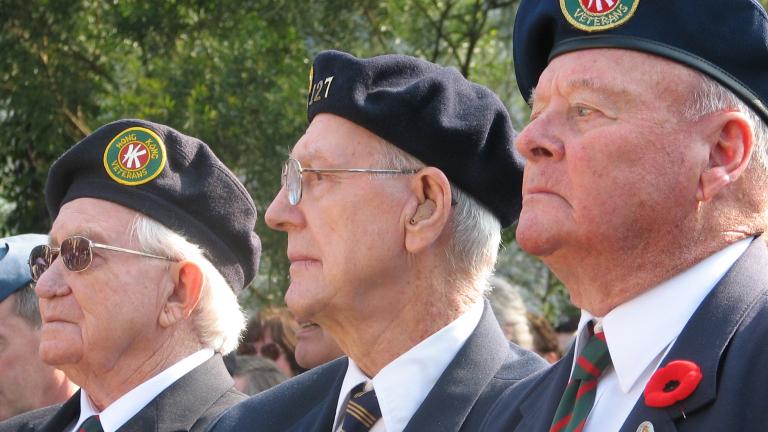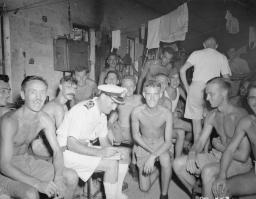Canadian soldiers joined the fight on December 18, when the Japanese army crossed from the mainland part of the colony to attack Hong Kong Island. Veteran George MacDonnell recalled the desperate struggle to defend Hong Kong Island in a February 2017 interview he gave for an oral history project by Crestwood School in Toronto:
"Our troops were extremely courageous and behaved extremely well on the battlefield. We really didn’t have a chance that we could [successfully] defend the island. The Japanese just kept pouring troops ashore. They were outstanding, experienced soldiers. They had a very large air force that constantly strafed us and bombed us, and they also had a strong naval force that often shelled us from the ocean. So it was just a cauldron of Hell."
The 1929 Geneva Convention on POWs offers protections to those captured during armed conflicts. POWs must be provided with adequate food, shelter and medical care. Japan had not ratified the convention, however, and throughout the Second World War, the Japanese military treated prisoners with extreme contempt, regularly violating their human rights. Prisoners of war were underfed, beaten, tortured, forced to perform hard labour and subjected to medical experiments.
The Red Cross did provide packages of food and medicine to POWs, but it was common for Japanese guards to keep the packages for themselves, or to force several prisoners to survive off the contents of one package. Despite these terrible conditions, soldiers still sometimes banded together to maintain morale, protect each other from harsh treatments and scavenge for food and supplies.[3] Some even sabotaged the shipyards they were forced to work at. Despite such solidarity, life in prison remained extremely difficult – and sometimes deadly.
"There wasn’t much you could do to survive in a prison camp," MacDonnell explained in his interview. "You got up at dawn, the roll was called and you went to work. You came back, you were fed and you went to bed… Malaria was a terrible problem. Malaria, bedbugs and dysentery… The chance of surviving was very small."
MacDonnell did manage to survive his time in prison camp, but 272 other Canadian soldiers did not. Even after being liberated in 1945, many Hong Kong veterans suffered from numerous health‐related issues. MacDonnell nearly lost his sight due to malnutrition and spent months recuperating in American and Canadian hospitals after the war. Others experienced nerve damage and gastrointestinal ailments, and yet others had lost toes or legs to gangrene and a lack of suitable medical attention. Many former POWs were traumatized by their experiences, and as a result, found it very difficult to hold down jobs or maintain healthy relationships.
Despite these difficulties, government support for the Hong Kong veterans was very limited. Veterans initially received $1 for each day they were prisoners of war, for a total of $1,360 each.[4] In 1958, the government gave veterans an additional $0.50 per day of imprisonment. This did not solve problems for veterans, however. Many continued to suffer due to physical and psychological disabilities. To make matters worse, until 1971, disability pensions were very difficult for veterans to access. Veterans had to prove that their time as a POW had caused the disability they were claiming for – something that wasn’t always easy to do for physical problems, and even more difficult for psychological disabilities.
In 1971, the government acknowledged the suffering of Hong Kong veterans and awarded each veteran a disability pension worth fifty per cent of the maximum pension amount.[5] Many veterans were grateful for this support, but they were also frustrated that they had never been paid for the forced labour they had performed while prisoners of war.
There were also emotional scars. Many veterans were bitter and angry about their prison experience, and dealt with their feelings in different ways. In 1983, veteran William Allister actually visited the Japanese shipyard where he was forced to labour during the war. He spent a month in Japan, and a son of one of the camp guards even spent a week as his guide in Tokyo. Afterwards, Allister felt he had begun to achieve some reconciliation. He also used painting to deal with his feelings, and even worked with artist Raymond Moriyama, who was imprisoned in a Japanese internment camp in British Columbia during the war. Other veterans found different paths to reconciliation. Starting in 1985, Jacob “Jack” Rose, formerly of the Winnipeg Grenadiers, spoke publicly in favour of redress for Japanese Canadians who had been imprisoned by the Canadian government during the war. He did this despite the fact that some of his fellow veterans were opposed to redress, because he believed that everyone should be treated fairly. Unfortunately, not all veterans were able to be so active, or cope as well with the physical and psychological effects of their imprisonment.
A report in 1987 revealed that Hong Kong veterans were, on average, aging faster and dying sooner than their contemporaries.[6] In that same year, the War Amps of Canada took the concerns of the Hong Kong veterans to the United Nations Commission on Human Rights, despite the lack of support from the Canadian government. Then, on December 11, 1998, the Canadian government awarded $24,000 in compensation to each surviving Hong Kong veteran or his widow. Finally, on December 8, 2011, seventy years to the day after the Japanese army had attacked Hong Kong, the Japanese government apologized to Canada’s Hong Kong veterans for the mistreatment of Canadian POWS.
Over the years, the Hong Kong veterans have fought at least three battles. The first was a military battle at Hong Kong and the second was a battle for survival in Japan’s POW camps. The veterans’ third struggle was a battle for recognition of the human rights violations they experienced during wartime, and a battle for compensation from the Canadian government for those injustices. This was their longest battle, spanning decades. By speaking out and sharing their stories, the Hong Kong veterans have helped Canadians better know their past and understand the importance of respecting everyone’s rights, even in wartime. It is important that we share the story of the Hong Kong veterans for many years to come.
The story of the Hong Kong veterans and their struggle for recognition and compensation can be found in the Museum’s Canadian Journeys gallery. This article was written in part using research conducted by Mallory Richard, who worked at the Museum as both a researcher and a project coordinator. The author would also like to thank Dr. Jeff Noakes, Historian of the Second World War at the Canadian War Museum and the Royal Canadian Legion for their guidance and assistance in the writing of this blog.
Author
Matthew McRae worked at the Museum as Researcher and as Digital Content Specialist.


